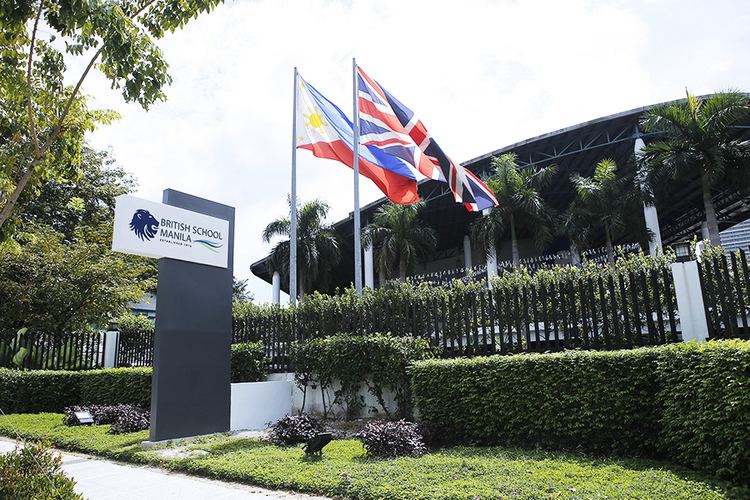Established 1976 Enrollment 900+ Affiliations FOBISSEAIAPS Mascot Lion Founded 1976 | Head of school Simon Mann Colour(s) Blue and White Phone +63 2 860 4800 Number of students 900 | |
 | ||
Type Private, international school, British school Address 36th Street, Taguig, 1634 Metro Manila, Philippines Accreditation International Baccalaureate Similar German European School Manila, San Lorenzo Ruiz de Manila School, French School of Manila Profiles | ||
Senators grill british school manila officials over student s death
The British School Manila (abbreviation: BSM) is a private international school in the Philippines. The school provides the highest quality of British education for children ages 3-18, following an adapted form of a British Curriculum and the IB Diploma. BSM students are prepared for end of Key Stage tests in Primary, GCSEs at 16, the International Baccalaureate Diploma at 18 and for life beyond school and university.
Contents
- Senators grill british school manila officials over student s death
- rio british school manila
- History
- Logo
- Campus
- Overview
- The Learning Powers
- Student learning
- References
In all comparative assessments, students at BSM perform well above UK expectations. As of 2015, over 97% of Year 11 students achieve the benchmark of 5 or more A*-C grades at GCSE. The school's IB pass rate (of over 98%) far exceeds international averages, and our students score an average total score of 36, 6 points above the world average of 30 (out of a maximum of 45 points).
rio british school manila
History
The British School Manila was founded in 1976, where it has grown from 2 classrooms and 32 students to over 900 students, representing 32 nationalities.
The school first operated in the old Union Church, then in 1980 moved to Merville, Parañaque. In September 2001, BSM relocated to purpose-built premises in Bonifacio Global City, in Metro Manila, Philippines, next to the International School Manila and the Manila Japanese School.
Two members of the British Royal Family have visited BSM. In 1999, Princess Anne visited the school's campus in Merville. She visited the school's current campus at Bonifacio Global City on 20 March 2015. In 2001, Prince Andrew, Duke of York attended the inauguration of the school's current campus at Bonifacio Global City. In 2004, he revisited the school to attend its GCSE awards ceremony.
Logo
In 2013, BSM launched a new logo, which was fully implemented by end of school year 2013–14. The new look BSM lion is an evolved, but simplified graphic version of the original – still blue and emoting British ethos – but now more "dynamic, engaged and international," reflecting the learning experience of every BSM student and the vibrant environment in which they are taught. Three dynamic floating ribbons have also been added to the logo. The central blue ribbon – the voice of the BSM lion – represents the constancy of BSM values, which remain at the heart of school life. The green and jade ribbons, which stream and intertwine around the blue, represent key elements of the BSM educational experience; the warmth and personal engagement of the BSM community and the school's dedication to nurturing the individual learning path of each BSM student.
Campus
With the exception of the Main Building, all of the buildings have been named after Philippine locations, people and iconic events (Anilao, Boracay, Cebu, Dinagyang, El Nido, Fiesta, Rizal). The maximum class size is 22 for all years with the exception of Year 12 and Year 13 where the aim for a maximum class size is of 16.
Facilities include an 8-lane 25-meter swimming pool, an on-campus 95x45m field using astroturfing for higher playability for tennis, football cricket and multiuse, another field that is 100x50m outside of campus for rugby, football and athletics, 8 well-equipped science laboratories, two music rooms for Primary and Senior and seven practice rooms in all, and two drama studios, seven ICT laboratories, interactive whiteboards in all teaching rooms.
Overview
The British School Manila provides opportunities for all students to learn and achieve success through acquiring, developing and applying knowledge, understanding and skills. The Curriculum is organised on the basis of five key stages:
The Learning Powers
As part BSM’s learning journey as a school, grounded in research, the school has developed a skills-based curriculum, currently underpinned by six ‘Learning Power’ dispositions, which include: independence, collaboration, communication, reflection, questioning and creativity.
These broad skill headings encapsulate a wider range of sub-skills such as organisation, perseverance, co-operation, leadership, empathy, listening, expressing, presenting, communicating, processing, problem solving, risk-taking, curiosity, critical thinking, reasoning, planning, evaluating and target setting. These dispositions are currently being reviewed and evolved to incorporate self-management strategies and research skills.
Student learning
BSM's programme is designed to fully prepare students to excel academically, but more importantly, to be successful and happy in their work and lives. BSM students are taught to be independent, collaborative, communicative, creative, questioning and reflective.
BSM encourages their students to integrate sports, service, residential trips, visual and performing arts, and a wide range of other opportunities within BSM's academic programme. The school prides itself on its strong sense of community and works closely with its students' families. This personal approach helps in understanding, developing and nurturing its students.
BSM's programme inculcates good values and a sense of responsibility. to the community through its service learning programme where it partners with various non-profit organisations. This is complimented with educational trips that open the students to different cultural settings. BSM encourages students to hone their skills in different fields through a "rich and diverse" after-school activity programme throughout their life at school.
